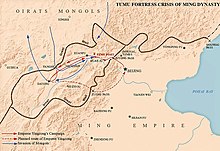Tumu Crisis
This article needs additional citations for verification. (August 2020) |
40°23′N 115°36′E / 40.383°N 115.600°E
| Crisis of the Tumu Fortress | |||||||
|---|---|---|---|---|---|---|---|
 | |||||||
| |||||||
| Belligerents | |||||||
|
Oirat Mongols | Ming dynasty | ||||||
| Commanders and leaders | |||||||
| |||||||
| Strength | |||||||
| 20,000 [1] | 500,000[2] | ||||||
| Casualties and losses | |||||||
| 5,000 | 250,000+ | ||||||
The Crisis of the Tumu Fortress (simplified Chinese: 土木堡之变; traditional Chinese: 土木堡之變), also known as the Tumu Crisis (simplified Chinese: 土木之变; traditional Chinese: 土木之變; Mongolian: Тумугийн тулалдаан), or the Jisi Incident (simplified Chinese: 己巳之变; traditional Chinese: 己巳之變), was a frontier conflict between the Northern Yuan and Ming dynasties. The Oirat ruler of the Northern Yuan, Esen, captured the Emperor Yingzong of Ming on September 1, 1449.[2]
Beginning of the conflict
In July 1449, Esen Taishi launched a large-scale, three-pronged invasion of the Ming with khagan Toqtaq-Buqa. He personally advanced on Datong (in northern Shanxi province) in August. The eunuch official Wang Zhen, who dominated the Ming court, encouraged the 22-year-old Emperor Yingzong of Ming to lead his own armies into battle against Esen. The size of Esen's army is unknown. The Ming army of about 500,000 personnel was hastily assembled; its command was made up of 20 experienced generals and a large entourage of high-ranking civil officials, with Wang Zhen acting as field marshal.
On August 3, Esen's army crushed a badly supplied Ming army at
Wang Zhen
Fearing that the restless soldiers would cause damage to his estates in Yuzhou, Wang Zhen decided to strike northeast and return by the same exposed route as they had come. The army reached
Esen sent an advance force to cut access to water from a river south of the Ming camp. By the morning of September 1 they had surrounded the Ming army. Wang Zhen rejected any offers to negotiate and ordered the confused army to move toward the river. A battle ensued between the disorganized Ming army and the advance guard of Esen's army (Esen was not at the battle). The Ming army basically dissolved and was almost annihilated. The Northern Yuan forces captured a huge quantity of arms and armour while killing most of the Ming troops. All the high-ranking Ming generals and court officials were killed. According to some accounts, Wang Zhen was killed by his own officers. The Emperor was captured, and on September 3 he was sent to Esen's main camp near Xuanfu.
Aftermath
Esen attempted to use the captured emperor to raise a ransom and negotiate a favourable treaty including trade benefits.[3] However, his plan was foiled in the Defense of Beijing due to the steadfast leadership of the Ming commander in the capital, General Yu Qian. The Ming leaders rejected Esen's offer, appointing Zhu Qizhen's brother as the Jingtai Emperor.[4]
The Ming never paid a ransom for the return of Zhu Qizhen, and Esen released him four years later after securing a weak trade deal. Zhu Qizhen was allowed to return to Beijing after agreeing to give up his claim to the throne, and was kept under house arrest at the Forbidden City. Esen faced growing criticism for his failure to exploit his victory over the Ming and was assassinated in 1455.[5] Zhu Qizhen retook the throne in 1457, after deposing his brother in a military coup.
See also
References
- ISBN 978-625-7636-31-5.
- ^ ISBN 978-0-313-33733-8 p. 151 [1]
- ^ Barfield 1992, p. 241.
- ISBN 978-0674072534.
- ^ Barfield 1992, p. 242.
Works cited
- Barfield, Thomas J (1992). The Perilous Frontier. Cambridge, Massachusetts: Blackwell publishers. p. 242. ISBN 1-55786-043-2.
Further reading
- "Cambridge History of China, Volume 7, The Ming Dynasty", edited by Twitchettand Mote, 1988.
- Frederick W. Mote. "The T'u-Mu Incident of 1449." In Chinese Ways in Warfare, edited by Edward L. Dreyer, Frank Algerton Kierman and John King Fairbank. Cambridge, MA: Harvard University Press, 1974.
- The Perilous Frontier, Chapter 7, 'Steppe Wolves and Forest Tigers: The Ming, Mongols and Manchus', Thomas J Barfield
